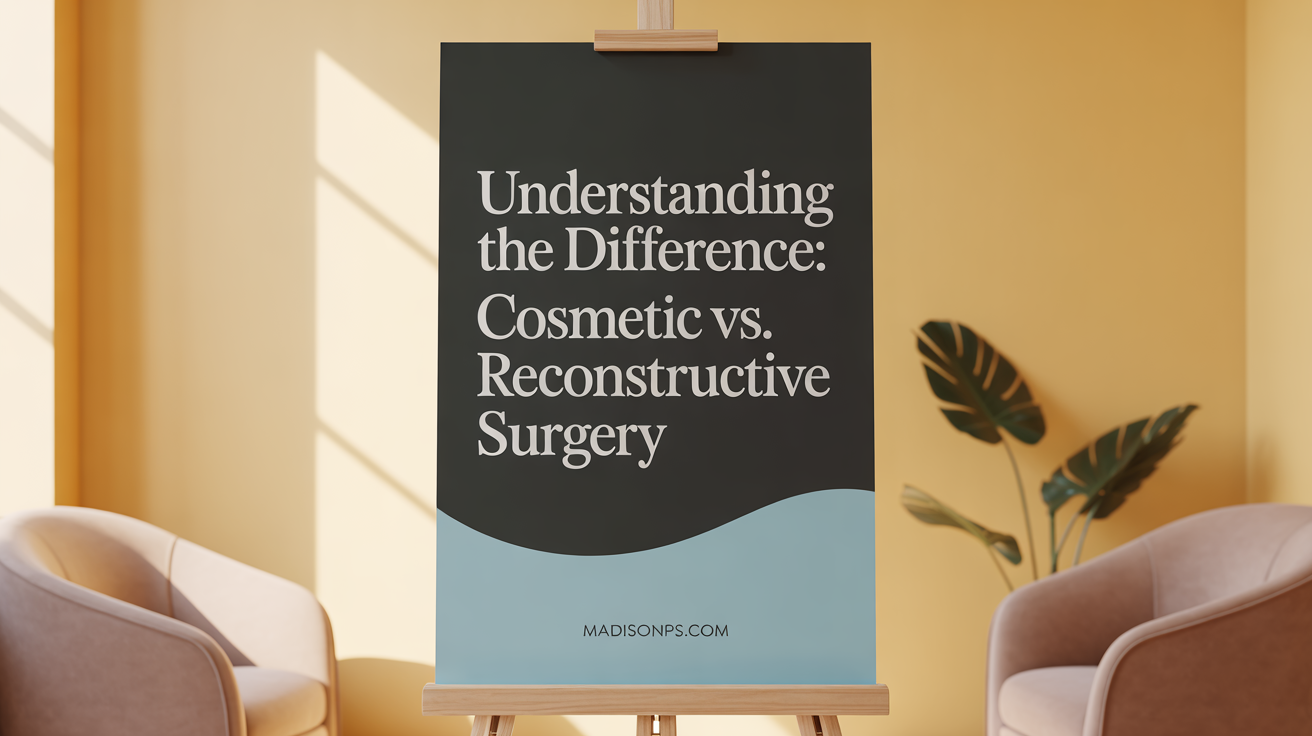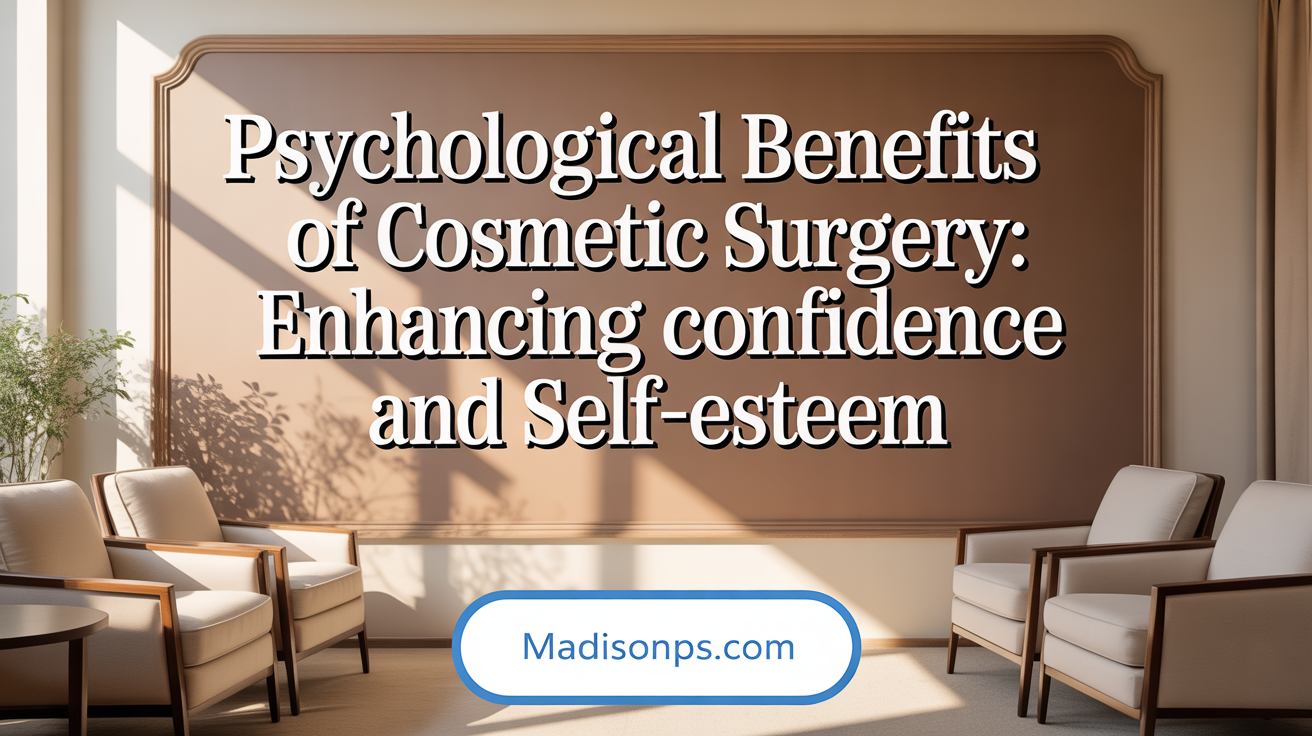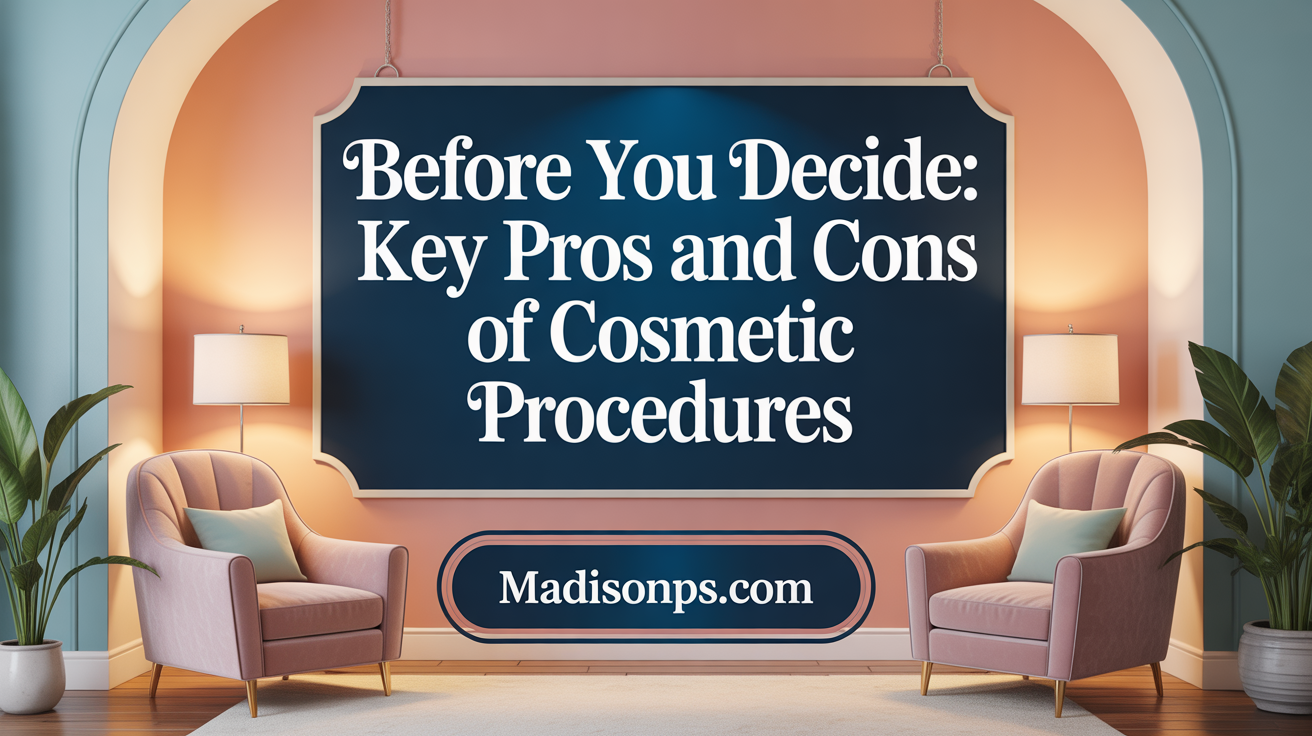
Table of contents
- Understanding the Distinction: Cosmetic versus Reconstructive Surgery
- The Psychological Impact: Enhancing Self-Esteem and Mental Health Through Cosmetic Surgery
- Weighing the Pros and Cons: What Patients Should Consider Before Surgery
- Aesthetic Surgery’s Role in Navigating Societal Beauty Standards and Fostering Self-Love
- Advancements and Innovations: Modern Techniques Enhancing Natural Results and Safety
- Aging Gracefully: How Aesthetic Procedures Support a Positive Aging Journey
- The Historical and Cultural Dimensions of Plastic Surgery in Shaping Beauty Ideals
- Challenging Stereotypes: Understanding Plastic Surgery Beyond Insecurity
- Personalized Approaches: Balancing Authenticity, Harmony, and Patient Empowerment
- Embracing Transformation: The Future of Beauty and Confidence Through Aesthetic Surgery
- References
A Journey into the Changing Landscape of Beauty and Confidence
Aesthetic surgery stands at the intersection of science and artistry, offering individuals the possibility not only to enhance their physical appearance but also to restore confidence and embrace self-expression. As societal perceptions of beauty evolve, so does the role of plastic surgery—from reconstructive procedures rooted in restoring function to advanced cosmetic treatments designed for natural, harmonious results. This article delves into how aesthetic surgery redefines beauty, supports mental well-being, and empowers personal transformation in contemporary culture.
Understanding the Distinction: Cosmetic versus Reconstructive Surgery

What is the difference between cosmetic and aesthetic surgery?
While the terms are often used interchangeably, cosmetic and reconstructive surgeries have distinct purposes and objectives.
Cosmetic surgery, also called aesthetic plastic surgery, is aimed at enhancing a person's appearance. It involves procedures that modify features to improve aesthetic appeal, such as shaping the face, breasts, or body contours. Many individuals opt for these procedures to boost confidence, self-image, or personal satisfaction.
In contrast, reconstructive surgery focuses on restoring function and appearance after injury, illness, or congenital conditions. It aims to repair deformities caused by trauma, birth defects, or medical issues like cancer. For example, reconstructive procedures include repairing cleft palates, burn scar reconstruction, or breast reconstruction after mastectomy.
Both fields share similar surgical techniques, but their core goals differ. Reconstructive surgery prioritizes restoring normal structure and function, while cosmetic surgery seeks to enhance or refine appearance. This fundamental distinction guides the choice of procedures and the approach taken by surgeons.
Understanding these differences helps patients make informed decisions aligned with their needs and expectations, whether they seek functional repair or aesthetic enhancement.
The Psychological Impact: Enhancing Self-Esteem and Mental Health Through Cosmetic Surgery

How does cosmetic surgery affect self-esteem and mental health?
Cosmetic surgery has the potential to significantly boost self-esteem and improve mental well-being by helping individuals feel more confident about their appearance. Many patients report feeling better about themselves after procedures like rhinoplasty, facelifts, or breast augmentation, which can lead to a more positive body image.
This improved confidence often translates into enhanced social interactions, greater career prospects, and an overall sense of happiness. For some, these procedures help alleviate feelings of self-consciousness, reducing symptoms of social anxiety or depression.
However, the psychological benefits depend on realistic expectations and proper counseling. When individuals understand what surgery can and cannot do, they are more likely to experience positive outcomes.
It's important to recognize that cosmetic surgery does not automatically address deep-seated insecurities or mental health issues. In certain cases, it might lead to increased dissatisfaction if expectations are unrealistic or if underlying psychological concerns go unaddressed.
While many find lasting benefits, some may experience dissatisfaction or develop further desires for additional procedures. It underscores the importance of preoperative psychological assessment and ongoing support.
In conclusion, cosmetic surgery can be a tool for enhancing self-esteem and mental health, but its success relies heavily on patient preparation, psychological readiness, and experienced medical guidance.
| Benefits of Cosmetic Surgery | Potential Risks | Considerations |
|---|---|---|
| Increased self-confidence | Dissatisfaction if expectations are unrealistic | Thorough psychological assessment |
| Better social interactions | Postoperative dissatisfaction | Clear communication with surgeon |
| Improved body image | Development of further insecurities | Realistic goals and counseling |
| Reduction in anxiety and depression | Unmet psychological needs | Support during recovery |
Understanding the psychological impacts helps ensure that patients are making informed decisions and receiving the support needed for positive outcomes in their self-image and mental health.
Weighing the Pros and Cons: What Patients Should Consider Before Surgery

What are the pros and cons of cosmetic surgery?
Cosmetic surgery offers a range of benefits that can greatly influence an individual's self-esteem and overall happiness. Many enjoy visible improvements in their appearance, which often leads to increased confidence and better social interactions. These procedures can also correct physical flaws or aging signs, and some even address functional issues, such as reconstructive needs after trauma or medical conditions.
However, there are important drawbacks to consider. Surgical procedures carry the risk of complications such as infections, scarring, or nerve damage. Not all results meet expectations, which can result in dissatisfaction or emotional distress. The cost can be significant, and many procedures are not covered by insurance, making them less accessible for some individuals.
Recovery times vary, with some procedures requiring weeks or months to heal fully. This downtime can impact work, daily activities, and personal life. Another serious consideration is the importance of selecting qualified, board-certified surgeons to ensure safety and optimal results.
Ultimately, weighing these advantages and disadvantages involves careful reflection and honest discussions with experienced professionals. Setting realistic expectations is vital to ensure satisfaction and safety. Recognizing both the potential benefits and possible risks helps patients make an informed decision aligned with their personal goals and circumstances.
Aesthetic Surgery’s Role in Navigating Societal Beauty Standards and Fostering Self-Love
How does cosmetic surgery relate to societal beauty standards and self-love?
Cosmetic surgery is closely linked to societal notions of beauty, often reflecting and reinforcing narrow ideals promoted through various media and cultural channels. These societal standards emphasize certain features or appearances as desirable, which can influence individuals’ perceptions of what they should look like.
Many people choose cosmetic procedures to boost their self-confidence, aiming to feel more authentic or in harmony with their self-image. For some, surgery becomes a tool for empowerment, helping them regain control over their bodies and express their uniqueness. For others, the motivation may stem from societal pressures to conform to prevailing beauty norms, which can lead to feelings of insecurity or dissatisfaction with their natural appearance.
Despite the increasing acceptance of aesthetics, a paradox exists: society often stigmatizes cosmetic procedures while simultaneously fostering a desire for them. Negative perceptions are rooted in traditional views that regard altering one’s appearance as superficial or problematic. Yet, the desire for aesthetic enhancement continues to grow, illustrating a societal tension between acceptance and judgment.
Cultural differences greatly influence beauty ideals. For example, preferences for certain facial features or body shapes vary worldwide, shaping individual motivations for cosmetic surgery. In some cultures, procedures are seen as a means of achieving social or professional success, while others view them as an expression of personal identity.
Overall, cosmetic surgery acts both as a reflection of societal values and a way to challenge them. It plays a role in shaping notions of beauty, influencing personal identity, and fostering self-love. When approached thoughtfully, it can help individuals feel more confident and true to themselves, promoting diversity and self-expression.
| Aspect | Influence | Notes |
|---|---|---|
| Media & Advertising | Shapes expectations | Constant exposure to idealized images alters perceptions of beauty |
| Cultural Norms | Define beauty ideals | Vary across regions, influencing motivations for surgery |
| Societal Attitudes | Stigma vs. acceptance | Complex views on cosmetic procedures affect personal choices |
| Self-Image | Impact on confidence | Surgery can enhance self-esteem but should align with personal values |
| Diversity & Representation | Promote inclusivity | Emphasize individual features over uniform standards |
Cosmetic surgery, therefore, operates within a societal context that both influences and is influenced by personal and cultural perceptions of beauty. When integrated with an understanding of self-worth and individuality, it can serve as a positive tool for self-expression and acceptance.
Advancements and Innovations: Modern Techniques Enhancing Natural Results and Safety

How are emerging technologies like 3D imaging and virtual consultations transforming plastic surgery?
Modern plastic surgery has embraced advanced technologies that allow patients and surgeons to collaborate more effectively. 3D imaging helps individuals visualize potential results before undergoing procedures, setting realistic expectations and planning with precision. Virtual consultations, on the other hand, make expert advice accessible regardless of location, enabling many to explore options comfortably from home.
What are minimally invasive procedures, and how do they offer faster recovery?
Minimally invasive options such as laser treatments, micro-needling, and chemical peels have gained popularity due to their reduced downtime and lower risks. These procedures often require smaller incisions or no cuts at all, leading to quicker healing, less discomfort, and fewer visible scars. Patients can enjoy rejuvenated features with minimal interruption to their daily lives.
How do modern techniques prioritize safety, accuracy, and natural results?
Advancements like precise surgical tools, enhanced imaging, and tailored approaches enhance safety and outcomes. Surgeons now emphasize natural-looking results by customizing treatments to each individual’s unique features, encouraging a harmonious balance that respects personal aesthetics.
What are some popular new treatments and tools used today?
Recent innovations include laser skin tightening, injectable neurotoxins, dermal fillers, and radiofrequency devices. These tools help refine facial features, improve skin texture, and restore youthful volume with less invasive methods. Such treatments are often complemented with 3D imaging and virtual planning to optimize results.
Aging Gracefully: How Aesthetic Procedures Support a Positive Aging Journey
How can aesthetic surgery help in aging gracefully and improving appearance over time?
Aesthetic surgery plays a significant role in helping people age with confidence and grace. As we grow older, signs of aging such as wrinkles, sagging skin, and volume loss become more noticeable. Aesthetic procedures address these issues effectively, offering both surgical and non-surgical options.
For those seeking more dramatic results, surgical procedures like facelifts, eyelid surgery, and neck lifts can tighten loose skin and restore a more youthful contour. These treatments help refresh facial features while maintaining natural appearance. Additionally, reconstructive options like dermal fillers and fat grafting can replace lost volume, smoothing out deep lines and enhancing facial symmetry.
Non-invasive treatments such as Botox, chemical peels, and laser therapy are popular choices for maintaining youthful skin. They improve skin texture, reduce fine lines, and promote collagen production, often with minimal downtime. These procedures are excellent for refining appearance over time and can be combined with surgical treatments for comprehensive rejuvenation.
The psychological benefits of maintaining a more youthful look include increased self-esteem, improved social interactions, and a sense of vitality. When individuals feel good about their appearance, it often translates into greater overall well-being and willingness to engage in life.
To achieve sustainable and natural-looking results, careful planning is essential. A personalized approach that considers individual aging patterns, health status, and aesthetic goals ensures outcomes that respect natural features and aging processes.
With advances in technology, aesthetic procedures are safer, less invasive, and more effective than ever. They empower individuals to age gracefully while embracing their uniqueness. Proper consultation with qualified specialists ensures treatment plans support both aesthetic desires and long-term health, making aging a positive experience.
The Historical and Cultural Dimensions of Plastic Surgery in Shaping Beauty Ideals
What is the historical and cultural significance of plastic surgery in shaping beauty standards?
Plastic surgery has a rich history that dates back thousands of years, with roots in ancient civilizations such as India, Egypt, and during the Renaissance period. Early reconstructive techniques were developed to address physical deformities caused by injuries, congenital conditions, or medical issues like cancer. Over time, these techniques evolved from functional repairs to aesthetic enhancements.
Throughout history, society’s perceptions of beauty have been influenced by cultural norms and values. In many societies, physical appearance became a symbol of social status, health, or moral virtue. As technology advanced, so did the sophistication and accessibility of procedures, moving from rudimentary reconstructions to complex cosmetic surgeries.
Today, the cultural significance of plastic surgery also reflects societal ideals and media influences. Social media platforms, celebrities, and fashion icons actively shape perceptions of beauty, often promoting idealized, digitally altered images. This cultural shift has increased awareness and acceptance of cosmetic procedures such as rhinoplasty, breast augmentation, and body contouring, which are often seen as pathways to improved self-esteem and social acceptance.
However, these evolving standards can also reinforce unattainable ideals. They may contribute to societal pressures, especially among the youth, to meet certain aesthetic criteria. Many individuals seek procedures not just for personal satisfaction but to align with modern beauty standards propagated by media and celebrity endorsements.
Cultural variations significantly influence the types of procedures popular in different regions. For example, South Korea emphasizes facial contouring, Brazil is renowned for body sculpting, and Thailand has a thriving medical tourism industry focusing on various aesthetic treatments. These differences highlight how local cultural norms and beauty ideals shape the plastic surgery landscape.
Overall, plastic surgery mirrors the complex interplay between technological progress, cultural values, and societal expectations. It continues to influence and be influenced by shifting perceptions of beauty, identity, and self-expression.
Challenging Stereotypes: Understanding Plastic Surgery Beyond Insecurity

Is opting for plastic surgery a sign of insecurity, and how does this perception affect individuals?
The idea that plastic surgery is solely a reflection of personal insecurity is a widespread societal stereotype. This perception can lead to unfair judgments and discourage people from pursuing procedures that might enhance their well-being.
In reality, motivations for undergoing cosmetic procedures are diverse. Many individuals seek aesthetic surgery to boost self-confidence, address body image concerns, or achieve personal goals, rather than because they feel insecure. Some patients pursue treatments to correct physical issues caused by medical conditions or trauma, which improves their quality of life.
Psychological factors are complex and vary from person to person. Research shows that when performed responsibly and with realistic expectations, plastic surgery can have positive effects on self-esteem and mental health. For example, procedures like rhinoplasty or facelifts can help individuals feel more comfortable and confident in social and professional settings.
Moreover, plastic surgery offers avenues for personal expression and individual empowerment. It allows people to reshape features in ways that align with their self-identity, supporting diversity and body positivity.
Understanding that motivations are multifaceted helps to demystify plastic surgery. It is not merely about correcting insecurities but also a form of self-care, self-expression, and in some cases, a medical necessity.
Summary Table of Motivations for Plastic Surgery
| Motivation | Explanation | Societal Impact |
|---|---|---|
| Self-confidence | Enhancing personal image to feel better about oneself | Promotes self-acceptance and empowerment |
| Medical necessity | Correcting deformities or issues from health conditions | Restores function and improves well-being |
| Body language and self-expression | Personalizing features to match identity, style, or expression | Supports diversity in beauty standards |
| Recovery from trauma or illness | Repairing physical damage to regain normalcy | Helps emotional and physical healing |
This nuanced understanding fosters a more supportive view of plastic surgery, emphasizing personal choice over societal stereotypes.
Personalized Approaches: Balancing Authenticity, Harmony, and Patient Empowerment
Philosophy Emphasizing Natural, Balanced Results
Modern aesthetic medicine prioritizes harmony and balance over perfection. Dr. Julie K. Gunther, founder of Wildfire Aesthetics, exemplifies this philosophy by focusing on individualized treatments that respect each person's unique features. The aim is to enhance natural beauty and achieve results that appear authentic, fostering a sense of self-confidence.
Role of Qualified Professionals and Patient-Surgeon Communication
Choosing experienced, certified professionals is crucial for safe, effective treatments. Open, honest discussions between patients and surgeons help set realistic expectations. This ensures that procedures align with personal goals while emphasizing safety and understanding the potential outcomes.
Techniques Like 'Tweakments' and Non-Surgical Interventions
Advancements include subtle adjustments, often called 'tweakments,' which refine features without drastic changes. Non-surgical options such as Botox, dermal fillers, and laser therapies allow for quick, minimally invasive enhancements. These techniques promote a natural look while offering flexibility and reduced downtime.
Promoting Inclusivity and Individualized Beauty Standards
The field strives to embrace diversity by recognizing that beauty is subjective. Tailored treatments empower individuals to define their own standards of attractiveness, challenging societal norms. This inclusive approach supports self-expression and promotes a broader acceptance of varied aesthetic preferences.
Through these personalized strategies, aesthetic procedures serve not only to improve appearance but also to boost confidence and reinforce a positive sense of identity.
Embracing Transformation: The Future of Beauty and Confidence Through Aesthetic Surgery
Aesthetic surgery continues to evolve as a powerful instrument reshaping traditional notions of beauty and confidence. By blending medical innovation with artistry, it offers individuals unprecedented opportunities for self-expression, empowerment, and psychological well-being. As the field advances with safer techniques, ethical practices, and personalized care, it champions diversity and body autonomy, encouraging people to define beauty on their own terms. Whether addressing the challenges of aging, healing from trauma, or enhancing natural features, aesthetic surgery ultimately supports a deeper journey toward self-love and acceptance in a changing societal landscape.
References
- Plastic Surgery: Redefining Beauty and Restoring Confidence
- Redefining Beauty Standards: The Transformative Role of Plastic ...
- Aesthetic plastic surgery for aging gracefully: redefining beauty at ...
- The Role of Plastic Surgery in Body Positivity and Self-Acceptance
- A Conversation on Confidence and Modern Aesthetics
- Cosmetic Surgery: What It Is, Types & Common Procedures
- A Psychologist Reveals Plastic Surgery's Ugly Mental Health Secrets
- This Post Will Change How You Think About Cosmetic Surgery